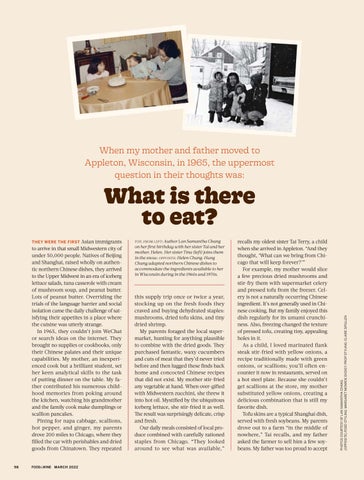When my mother and father moved to Appleton, Wisconsin, in 1965, the uppermost question in their thoughts was:
Asian immigrants to arrive in that small Midwestern city of under 50,000 people. Natives of Beijing and Shanghai, raised wholly on authentic northern Chinese dishes, they arrived to the Upper Midwest in an era of iceberg lettuce salads, tuna casserole with cream of mushroom soup, and peanut butter. Lots of peanut butter. Overriding the trials of the language barrier and social isolation came the daily challenge of satisfying their appetites in a place where the cuisine was utterly strange. In 1965, they couldn’t join WeChat or search ideas on the internet. They brought no supplies or cookbooks, only their Chinese palates and their unique capabilities. My mother, an inexperienced cook but a brilliant student, set her keen analytical skills to the task of putting dinner on the table. My father contributed his numerous childhood memories from poking around the kitchen, watching his grandmother and the family cook make dumplings or scallion pancakes. Pining for napa cabbage, scallions, hot pepper, and ginger, my parents drove 200 miles to Chicago, where they filled the car with perishables and dried goods from Chinatown. They repeated THEY WERE THE FIRST
98
MARCH 2022
top, from left: Author Lan Samantha Chang
on her first birthday with her sister Tai and her mother, Helen. Her sister Tina (left) joins them in the snow. opposite: Helen Chung-Hung Chang adapted northern Chinese dishes to accommodate the ingredients available to her in Wisconsin during in the 1960s and 1970s.
this supply trip once or twice a year, stocking up on the fresh foods they craved and buying dehydrated staples: mushrooms, dried tofu skins, and tiny dried shrimp. My parents foraged the local supermarket, hunting for anything plausible to combine with the dried goods. They purchased fantastic, waxy cucumbers and cuts of meat that they’d never tried before and then lugged these finds back home and concocted Chinese recipes that did not exist. My mother stir-fried any vegetable at hand. When over-gifted with Midwestern zucchini, she threw it into hot oil. Mystified by the ubiquitous iceberg lettuce, she stir-fried it as well. The result was surprisingly delicate, crisp and fresh. Our daily meals consisted of local produce combined with carefully rationed staples from Chicago. “They looked around to see what was available,”
recalls my oldest sister Tai Terry, a child when she arrived in Appleton. “And they thought, ‘What can we bring from Chicago that will keep forever?’” For example, my mother would slice a few precious dried mushrooms and stir-fry them with supermarket celery and pressed tofu from the freezer. Celery is not a naturally occurring Chinese ingredient. It’s not generally used in Chinese cooking. But my family enjoyed this dish regularly for its umami crunchiness. Also, freezing changed the texture of pressed tofu, creating tiny, appealing holes in it. As a child, I loved marinated flank steak stir-fried with yellow onions, a recipe traditionally made with green onions, or scallions; you’ll often encounter it now in restaurants, served on a hot steel plate. Because she couldn’t get scallions at the store, my mother substituted yellow onions, creating a delicious combination that is still my favorite dish. Tofu skins are a typical Shanghai dish, served with fresh soybeans. My parents drove out to a farm “in the middle of nowhere,” Tai recalls, and my father asked the farmer to sell him a few soybeans. My father was too proud to accept
PHOTOS COURTESY OF LAN SAMANTHA CHANG (OPPOSITE) FOOD STYLING: MARGARET MONROE DICKEY; PROP STYLING: CLAIRE SPOLLEN
What is there to eat?













